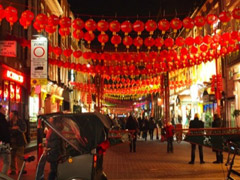


London’s Chinatown is pretty much contained between Shaftesbury Avenue to the north and Lisle Street to the south, just a few metres away from the tourist trap of Leicester Square. However at the start of the 20th century, the East End neighbourhood of Limehouse was home to a very different Chinatown, a much seedier place preceded by tales of opium dens and crime.
Limehouse had been a major port since medieval times, but it wasn’t till the 19th century that the Docklands saw the most expansion. Among the new developments was the marina now known as the Limehouse Basin, initially called Regent’s Canal Dock when it was built in 1820. The new dock was used to unload cargo which could then be transported along the Regent’s Canal to reach other parts of the country.
In terms of living conditions Limehouse was a slum. Although commerce was flourishing and an influx of migrant workers were arriving to work here, they were housed in cramped, squalid tenements and their wages were minimal. Dock workers of different nationalities congregated separately; West Indian sailors could be found in Shadwell for instance, while the Spanish would frequent Wapping.
Chinese sailors tended to settle in two places: Poplar if they came from Shanghai, and Limehouse if they hailed from southern China. They arrived on ships carrying silks, ceramics and tea, but the general public was deeply suspicious of them. An image of the Chinese as malicious and conniving, involved in gambling, drugs and other crimes was popularised by the Fu Manchu series of novels written by Sax Rohmer, the first of which was published in 1912. In the books, which became bestsellers, Fu Manchu is a criminal mastermind who plots to take over the world, and who favours unconventional weapons like venomous snakes and fungi. Somehow gullible Edwardian audiences believed this to be a realistic portrayal. \n\nOther books with similar characters followed, like the outlaws in Agatha Christie’s The Big Four, and some were even adapted in Hollywood, like The Chink and the Child by D.W. Griffiths, based on one of the Limehouse Nights short stories by Thomas Burke, further cementing the racial stereotype.
Newspaper headlines stirred panic; Limehouse was believed to be a haven for opium dens, into which evil Chinese gangsters were luring young English women, encouraging them to become addicted to the drug before forcing them into slavery. The truth is that Chinese men were marrying English women, simply because more males than females had come over to Britain for work, and there were many who disapproved of the intermarriages.
The use of opium was a major tool used against the Chinese (somewhat hypocritical given the large amounts of opium the British imported from India to then pump into China in exchange for other goods). In 1918 actress Billie Carleton was found dead in her room at The Savoy; the media had a field day pinpointing her death on the opium and cocaine supplied to her by a Chinese dealer from Limehouse, however she was also a frequent user of barbiturates, which are more likely to have killed her. Moreover, there is hardly any photographic evidence of opium dens in London, therefore it seems this “epidemic” was hugely exaggerated by journalists and writers.
The hysteria resulted in several riots, some of which turned violent. But the reality of Limehouse was very different to what many Londoners believed, as instead of being the sleazy centre of vice it was depicted as, it was a quiet area home to Chinese-owned shops, launderettes and restaurants.
\n\nThe 1921 census, when the Chinese community in Limehouse was at its largest, puts the figure at 337. They mostly inhabited the streets around Limehouse Causeway, and when this was expanded and some of the surrounding roads demolished in 1934, many moved away. The shipping industry was in demise by now, and this along with the destruction of the area during the Second World War meant the inhabitants had to find new homes elsewhere.
Some moved to the West End, and were joined by immigrants from Hong Kong who started arriving in the 1950s. They were attracted to the area by a thriving restaurant business; British soldiers who’d been to the Far East had returned with a taste for Asian food. Upmarket Chinese restaurants such as The Asiatic had Hollywood stars as customers, which put exotic dishes like Peking duck and sweet and sour pork firmly on the map.
By the 1970s there were Chinese herbalists, barber shops, accountants and libraries as well as restaurants in the new Chinatown; today there are nearly 80 restaurants, and over 50 shops and supermarkets, some of which also sell Korean, Japanese and Thai products. For anyone with a passing interest in Asian food, these supermarkets stock everything from confectionery to seaweed.
Few Chinese people actually live there, but the area attracts many visitors. In recognition of this Westminster Council decided to make Chinese New Year celebrations official from February 1985 onwards, and towards the end of the decade the brightly coloured lanterns and the “pagoda” were installed, so there’d be no mistaking where you were. It’s a far cry from the murky, fictional image of the Chinatown of a hundred years ago.


